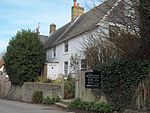The Lewes and Laughton Levels are an area of low-lying land bordering the River Ouse near Lewes and the Glynde Reach near Laughton in East Sussex, England. The area was probably a tidal inlet in Norman times, but by the early 14th century, some meadows had been created by building embankments. Conditions deteriorated later that century, and by 1537, most of the meadows were permanently flooded. Part of the problem was the buildup of shingle across the mouth of the Ouse, but in 1537 a scot tax was raised, and a new channel cut through the shingle. By the mid 17th century, shingle was again preventing the region from draining properly, until the new channel was reinstated around 1731. In 1758 John Smeaton surveyed the area with a view to improving it for agriculture. He suggested straightening and widening the river channel, raising the banks around meadows, and building a large sluice near Piddinghoe, to keep the tides out. Some dredging and widening were carried out, but the straightending and sluice were discarded.
In 1788, William Jessop surveyed the whole river, with the main object of improving navigation. The Ouse above Lewes became the River Ouse Navigation, with 19 locks, and for the lower river, he suggested radical straightening, and removal of the shingle bar near the mouth of the river. The work was overseen by a Lewes schoolmaster and civil engineer, and was completed in 1795. Similar treatment of the Glynde Reach occurred between 1796 and 1803, and as well as enabling ships to reach Lewes, the faster moving tides drained the meadows much more effectively. Improvements continued in the early 19th century under the leadership of John Ellman, a renowned agriculturalist who became the Expenditor for the Lewes and Laughton Levels. Severe floods occurred in 1829, but the meadows drained within 48 hours.
Management of the flood defences for the Levels passed to the River Ouse Catchment Board in 1939, following the passing of the Land Drainage Act 1930. After three reorganisations and the subsequent privatisation of the water industry, responsibility passed to the Environment Agency, who suggested in 2012 that the land drainage functions should be managed by a local internal drainage board. Lewes District Council objected, and agreed to fund flood and coastal erosion management after the Environment Agency's internal drainage district for the Ouse was formally abolished from 31 March 2017.












